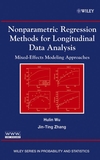 |
Nonparametric Regression Methods for Longitudinal Data Analysis: Mixed-Effects Modeling ApproachesBy Hulin Wu and Jin-Ting Zhang |
Preface
Contents
Datasets
Matlab Software
Order Book
Preface
Nonparametric regression methods for longitudinal data analysis have been a popular statistical research topic since the late 1990s. The needs of longitudinal data analysis from biomedical research and other scientific areas along with the recognition of the limitation of parametric models in practical data analysis have driven the development of more innovative nonparametric regression methods. Because of the flexibility in the form of regression models, nonparametric modeling approaches can play an important role in exploring longitudinal data, just as they have done for independent cross-sectional data analysis. Mixed-effects models are powerful tools for longitudinal data analysis. Linear mixed-effects models, nonlinear mixedeffectsmodels and generalized linearmixed-effectsmodels have beenwell developed to model longitudinal data, in particular, for modeling the correlations and withinsubject/ between-subject variations of longitudinal data. The purpose of this book is to survey the nonparametric regression techniques for longitudinal data analysis which are widely scattered throughout the literature, and more importantly, to systematically investigate the incorporation of mixed-effects modeling techniques into various nonparametric regression models.
The focus of this book is on modeling ideas and inference methodologies, although we also present some theoretical results for the justification of the proposed methods. The data analysis examples from biomedical research are used to illustrate the methodologies throughout the book. We regard the application of the statistical modeling technologies to practical scientific problems as important. In this book, we mainly concentrate on the major nonparametric regression and smoothing methods including local polynomial, regression spline, smoothing spline and penalized spline
Chapter 1 provides a brief overviewof the book chapters, and in particular, presents data examples frombiomedical research studieswhich havemotivated the use of nonparametric regression analysis approaches. Chapters 2 and 3 review mixed-effects models and nonparametric regression methods, the two important building blocks of the proposed modeling techniques. Chapters 4~7 present the core contents of this book with each chapter covering one of the four major nonparametric regression methods including local polynomial, regression spline, smoothing spline and penalized spline. Chapters 8 and 9 extend the modeling techniques in Chapters 4??7 to semiparametric and time varying coefficient models for longitudinal data analysis. The last chapter, Chapter 10, covers discrete longitudinal datamodeling and analysis.
Most of the contents of this book should be comprehensible to readers with some basic statistical training. Advancedmathematics and technical skills are not necessary for understanding the key modeling ideas and for applying the analysis methods to practical data analysis. The materials in Chapters 1??7 can be used in a lower or medium level graduate course in statistics or biostatistics. Chapters 8??10 can be used in a higher level graduate course or as reference materials for those who intend to do research in this area.
We have tried our best to acknowledge the work of many investigators who have contributed to the development of the models and methodologies for nonparametric regression analysis of longitudinal data. However, it is beyond the scope of this project to prepare an exhaustive review of the vast literature in this active research field and we regret any oversight or omissions of particular authors or publications.
We would like to express our sincere thanks to Ms. Jeanne Holden-Wiltse for helping us with polishing and editing themanuscript. We are grateful toMs. Susanne Steitz andMr. Steve Quigley at JohnWiley & Sons, Inc. who havemade great efforts in coordinating the editing, review, and finally the publishing of this book. We would like to thank our colleagues, collaborators and friends, Zongwu Cai, Raymond Carroll, Jianqing Fan, Kai-Tai Fang, Hua Liang, James S. Marron, Yanqing Sun, Yuedong Wang, and Chunming Zhang for their fruitful collaborations and valuable inspirations. Thanks also go to Ollivier Hyrien, Hua Liang, Sally Thurston, and Naisyin Wang for their review and comments on some chapters of the book. We thank our families and loved ones who provided strong support and encouragement during the writing process of this book. We are grateful to our teachers and academic mentors, Fred W. Huffer, Jinhuai Zhang, Jianqing Fan, Kai-Tai Fang and James S. Marron, for guiding us to the beauty of statistical research. J.-T. Zhang also would like to acknowledge Professors Zhidong Bai, Louis H. Y. Chen, Kwok Pui Choi and Anthony Y. C. Kuk for their support and encouragement.
Wu’s research was partially supported by grants from the National Institute of Allergy and Infectious Diseases, the National Institutes of Health (NIH). Zhang’s research was partially supported by the National University of Singapore Academic Research grant R-155-000-038-112. The book was written with partial support from the Department of Biostatistics and Computational Biology, University of Rochester, where the second author was a Visiting Professor.
